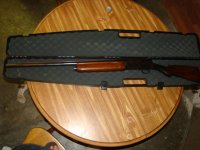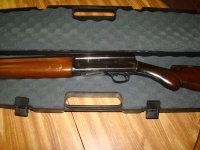Recently acquired a 12 gage semi automatic remington shotgun and was wondering how to tell what year it is? It only has patent dates and manufacturer on barrel. I think the serial number is 85665. That is the only marks on the gun that I can find. Any info that might help would be great.
You are using an out of date browser. It may not display this or other websites correctly.
You should upgrade or use an alternative browser.
You should upgrade or use an alternative browser.
identifying 12 gage remington
- Thread starter sparks844
- Start date
jaguarxk120
New member
Please post a picture of the gun. That picture will tell everything about it.
Appears to be a Remington Model 11.
http://www.remington.com/library/history/firearm_models/shotguns/model_11.asp
http://www.remingtonsociety.com/questions/BLACKPOWDERX.htm
http://www.remington.com/library/history/firearm_models/shotguns/model_11.asp
http://www.remingtonsociety.com/questions/BLACKPOWDERX.htm
Last edited:
impalacustom
New member
Model 11's are similar but not the same as A5's.
No, more than similar. It's the same basic John Browning design with, yes, some very small differences like, for instance, lack of a cut-off lever on the Remington guns. John B. partnered with FN 1st and the gun was christened the A5. A few years later a deal to allow Remington to produce the same gun in the U.S. was worked out, and Remington called their version the Model 11. Basic design is the same. Savage also came out with their version of the A5/Model 11 later still. Again, same design. And there were several other knock-offs over the years.
http://world.guns.ru/shotgun/sh41-e.htm
http://cosmolineandrust.blogspot.com/2006/10/remington-model-11-very-belligerent_29.html
http://www.wisnersinc.com/additional_info/remington_11.htm
http://world.guns.ru/shotgun/sh41-e.htm
http://cosmolineandrust.blogspot.com/2006/10/remington-model-11-very-belligerent_29.html
http://www.wisnersinc.com/additional_info/remington_11.htm
Last edited:
armsmaster270
New member
It's in damn good condition also. The stocks and forends tended to split I had to replace 2 on mine finally went with the synthetic ones not as purty but functional..
I don't think it's a Model 11. I think it's earlier than that - at least I think the receiver is. Note the low serial number and safety in front of the trigger. I think this is one of the guns that Remington manufactured during the first five years that their company was licensed to manufacture guns under the Browning patent. That early gun was called "The Remington Auto-Loading Shotgun". I think that's what we see here. The "Remington Auto-Loading Shotgun" was the gun Remington manufactured under from 1905 through 1910. In 1911 they made a few design changes to the gun and re-named it the Model 11. I believe that MODEL 11 was roll-marked on the breech bolt of all true Model 11's. I don't see that on the OP's gun. I also note that on the left hand side of the OP's receiver (that's the shooter's left, when the gun is held in firing position) there appears to be a single screw in the place where a Model 11 has a double screw setup.
scorpion_tyr
New member
Go to Remington's website, find the contact us tab and send them the serial number. They'll tell you when it was made and what model it is.
Model 11's are similar but not the same as A5's.
Actually done some research. For a bit, during WW2, Remington made the Auto-5 FOR Browning, they were stamped Browning, but Remington built them. Same gun, minor differences.
impalacustom
New member
Again similar but not the same. Take a Browning or FN barrel and try to put it in a Model 11 and shoot it, watch what happens. Put a Model 11 bolt into a Browning or FN and see how well it works. The tangs are shaped different on the Savage 720, Browning A5, FN, and the Model 11. Don't believe me, try the stock on one and put on another. Even the recoil springs are different, as are some of the screws, such as the tang locking screw, Browning used a smaller screw than Remington. Brownings didn't have the recoil buffer but Remington did. They are similar but not the same.
All the guns were manufactured under Brownings patent, yes but they are not exactly the same.
All the guns were manufactured under Brownings patent, yes but they are not exactly the same.
In that era, of course you will always see small differences in the same design as built by different manufacturers. It was obviously before the improved machining capabilities that were developed during the war years (both wars), and 85+ years before the CNC machining we know today began to appear. Short of military involvement in the manufacturing process, you would have always seen dimensional differences, just as you would have seen improvements and adaptations of any shared design, over time. That is only to be expected. When I say 'same gun', I'm obviously speaking generically. I intended to make it clear I was referring to the same basic design...different manufacturers working off the same patent, adding their unique touches. So, of course, you would never expect to be able to swap every part between different manufacturers' models. Of course, one manufacturer might decide to make a tang longer or shorter, thinner or fatter. Of course barrel dimensions might be different enough that they would not interchange between manufacturers. Of course spring arrangements might be slightly different. Because, of course, each manufacturer would want it's own signature on a shared design to differentiate it just a bit from the other guys' and also to make the gun's manufacturing process fit the capabilities of their own individual physical plant as best as possible. But, then again, typically you could not buy parts from the same manufacturer and expect them to fit without some time spent fitting them. Final hand fitting was the rule, not the exception, in those years.
Last edited:



